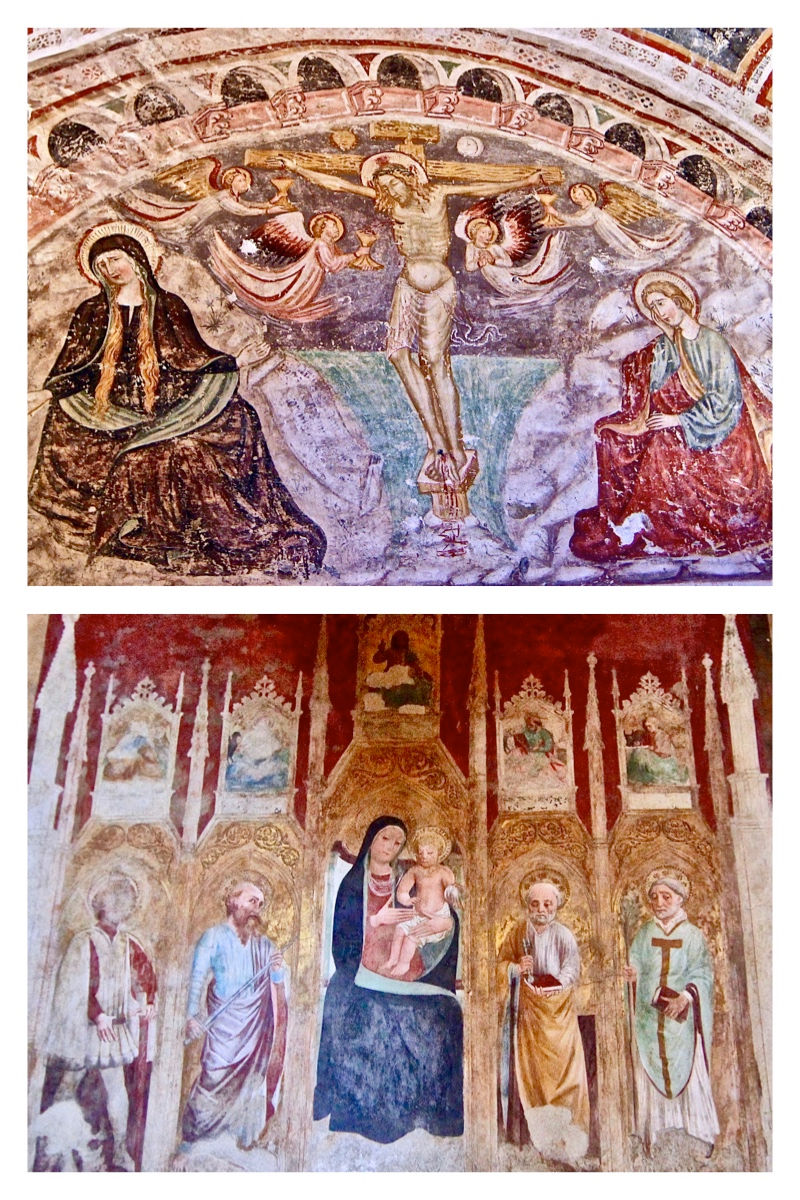Church of Sant'Agostino
- Kathy kathysfarmitaly@gmail.com

- Jun 8
- 4 min read
Montefalco, Italy

Walking through a castle, as one does in Italy, enjoying the shops and the people in Montefalco, Italy, a town in the Umbria region of Italy, we came across the Church of Sant'Agostino, a small Gothic-style church built in the 13th century. It was completed in 1275 and dedicated to Saint Augustine, Bishop and Doctor of the Church.
The church is in between shops and across from a butcher—an odd juxtaposition. The front is unremarkable, aside from the large iron doors, but those are a common sight in Italy. One wouldn't necessarily notice it if they were only focused on the pretty shop windows. But I will take any opportunity to sneak into a courtyard, an abandoned building, a back alley, or a side street to find interest and adventure, so I snuck in and discover ancient history.
My gracious hosts, Cathy and Enrico from Solebello, were wonderful in letting me wander (while keeping a close eye on me), answering questions, and acting as my interpreter while I chatted with many strangers and shop owners.
Upon walking inside this ancient building, you don't have to be a 'believer' to feel the enormity of its history and symbolism.

The Church of Sant'Agostino in Montefalco is an example of Umbrian Gothic architecture, reflecting the strong presence of the Augustinian order in the region during the 13th century. Its construction began around 1270, soon after the Augustinian friars established their presence in Montefalco. Its rapid completion in 1275 mirrored the era's religious intensity and the rise of mendicant orders.

While not as grand as some cathedrals, Sant'Agostino's design emphasizes the simplicity and functionality characteristic of the Augustinian ethos, yet it was originally adorned with magnificent frescoes that served as visual sermons for the largely illiterate populace. Over the centuries, this church has stood witness to Montefalco's fortunes, surviving earthquakes, political upheavals, and even the Napoleonic suppression of religious orders, though it often suffered from periods of neglect.

Unfortunately, the church fell into a state of disrepair over time due to vandalism. So now volunteers keep vigil. One opens and closes the church, others offer information and even the shop keepers help out to preserve their beloved piece of history.
The walls are covered in fresco paintings, some damaged from the ravages of time over hundreds of years and the damn vandals. The glass coffins were in good shape, but the bodies inside were a sight to see.

The volunteer docent that day was a lovely man. He was passionate about the church and its history, and he had kind and wise eyes. With Cathy's interpretation, the docent and I connected immediately and had a wonderful and moving conversation. I told him about my mother, a devout Catholic, and her disagreement with the church. It was a dispute over reincarnation. She believed in it, but the church did not, so they parted ways. Even after that ridiculous, rigid, and hurtful nonsense, Mom remained a devout Catholic. She may have stopped attending church, but she prayed—a lot. In her later years, in her 80s, we occasionally heard her talking to Jesus, Mary, and, of course, God.* She also prayed to St. Anthony, the patron saint, for the recovery of lost items, hoping to find her glasses and the TV remote control.
*Note to evangelical Christians: Mom understood, as do all Catholics, that there is only one God. A few Christians have told me Catholics aren't Christians because they believe in different Gods. No, they only believe in one God, but they also like to have chats with God's representatives. It's like asking a friend to pray for you, but these 'friends' are with God.
The core of their faith is monotheistic, centered on the Holy Trinity: God the Father, God the Son (Jesus Christ), and God the Holy Spirit. They believe these three are distinct persons but one God. So, when Catholics "pray" to Mary or the saints, it's essential to understand what they mean by "pray" in that context. It's not worship, which is reserved for God alone. Instead, it's a form of intercession or veneration.
Mom praying to Mary for the safe return of our soldiers or asking St. Anthony to carry home the souls of the dead she would read about in the daily obituaries (yup, Mom prayed for strangers) didn't mean she thinks they are "Gods." They are "assistants." God is busy.
The docent then took us into a locked room that the public wasn't allowed to enter. It was the sacristy, a room where priests prepare for mass, but the docent explained that for centuries, the priests received communion in the privacy of that room. It was surreal.

Please note: I don't want to minimize the centuries of abuse from the church. I don't mean to be a downer, but without a brief acknowledgment of the massacres, secrets, and dark history of the church, I am doing a disservice to the truth in history. It's important that we call out institutions for the brutal treatment of people.
That said, it's hard not to marvel at the art, symbolism, corpses encased in glass, and the sheer length of time the church has stood. The walls have witnessed the development of Italian civilization. This church has survived many attacks, and it still holds those stories.





Comments